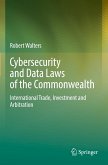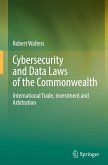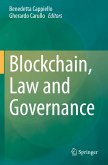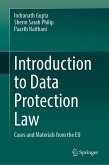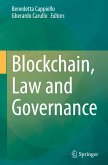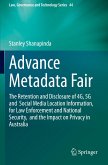- Gebundenes Buch
- Merkliste
- Auf die Merkliste
- Bewerten Bewerten
- Teilen
- Produkt teilen
- Produkterinnerung
- Produkterinnerung
The book offers a provocative review of thinking about privacy and identity in the years encompassing and disrupted by the two world wars of the first half of the twentieth century - focusing (in particular) on the socio-technological transformations associated with modernism. It argues that, with many of the most interesting modern thinkers of the period dead or marginalised (or both) by 1948, their ideas about how rights such as privacy should develop to accommodate the exigencies of modern life failed to find much of a voice in the drafting of the Universal Declaration of Human Rights. Yet…mehr
Andere Kunden interessierten sich auch für
![Cybersecurity and Data Laws of the Commonwealth Cybersecurity and Data Laws of the Commonwealth]() Robert WaltersCybersecurity and Data Laws of the Commonwealth123,99 €
Robert WaltersCybersecurity and Data Laws of the Commonwealth123,99 €![Cybersecurity and Data Laws of the Commonwealth Cybersecurity and Data Laws of the Commonwealth]() Robert WaltersCybersecurity and Data Laws of the Commonwealth123,99 €
Robert WaltersCybersecurity and Data Laws of the Commonwealth123,99 €![Blockchain, Law and Governance Blockchain, Law and Governance]() Blockchain, Law and Governance131,99 €
Blockchain, Law and Governance131,99 €![Introduction to Data Protection Law Introduction to Data Protection Law]() Indranath GuptaIntroduction to Data Protection Law67,99 €
Indranath GuptaIntroduction to Data Protection Law67,99 €![Blockchain, Law and Governance Blockchain, Law and Governance]() Blockchain, Law and Governance131,99 €
Blockchain, Law and Governance131,99 €![Hacking Exposed Computer Forensics, Second Edition Hacking Exposed Computer Forensics, Second Edition]() Aaron PhilippHacking Exposed Computer Forensics, Second Edition59,99 €
Aaron PhilippHacking Exposed Computer Forensics, Second Edition59,99 €![Advance Metadata Fair Advance Metadata Fair]() Stanley ShanapindaAdvance Metadata Fair108,99 €
Stanley ShanapindaAdvance Metadata Fair108,99 €-
-
-
The book offers a provocative review of thinking about privacy and identity in the years encompassing and disrupted by the two world wars of the first half of the twentieth century - focusing (in particular) on the socio-technological transformations associated with modernism. It argues that, with many of the most interesting modern thinkers of the period dead or marginalised (or both) by 1948, their ideas about how rights such as privacy should develop to accommodate the exigencies of modern life failed to find much of a voice in the drafting of the Universal Declaration of Human Rights. Yet they anticipated in surprising ways some of our 'new' ways of thinking in more recent times. After a brief introduction, the chapters are framed in terms of case studies on the right to privacy, the right to data protection and the right to be forgotten, each finishing with a consideration of how these rights require further rethinking in the digital century.
Hinweis: Dieser Artikel kann nur an eine deutsche Lieferadresse ausgeliefert werden.
Hinweis: Dieser Artikel kann nur an eine deutsche Lieferadresse ausgeliefert werden.
Produktdetails
- Produktdetails
- Verlag: Springer Nature Singapore / Springer Singapore
- 2024 edition
- Erscheinungstermin: 23. April 2024
- Englisch
- ISBN-13: 9789819944972
- ISBN-10: 981994497X
- Artikelnr.: 68186830
- Herstellerkennzeichnung
- Libri GmbH
- Europaallee 1
- 36244 Bad Hersfeld
- gpsr@libri.de
- Verlag: Springer Nature Singapore / Springer Singapore
- 2024 edition
- Erscheinungstermin: 23. April 2024
- Englisch
- ISBN-13: 9789819944972
- ISBN-10: 981994497X
- Artikelnr.: 68186830
- Herstellerkennzeichnung
- Libri GmbH
- Europaallee 1
- 36244 Bad Hersfeld
- gpsr@libri.de
Megan Richardson is a Professor in the Melbourne Law School at the University of Melbourne and author of The Right to Privacy: Origins and Influence of a Nineteenth-Century Idea (Cambridge University Press, 2017) and Advanced Introduction to Privacy Law (Edward Elgar, 2020).
Chapter 1:In 1905 Spanish philosopher and cultural critic George Santayana
wrote that "those who cannot remember the past are doomed to repeat it".
Ten years later the world was at war. The right to privacy featured in art
12 of the Declaration, alongside rights to family, home and correspondence,
and to honour and reputation. But, due to its attenuated framing and
limited attention paid to more contestable ideas about what a modern right
to privacy might encompass, alongside other rights needed for the
protection of identity in modern life, it amounted largely to a restatement
- albeit a highly significant restatement - of the importance of the right
to privacy in modern times. Instead, most of the modern developments around
the right to privacy and contiguous rights have occurred spasmodically in
the years since the Universal Declaration was agreed in a rare moment of
international consensus.
Chapter 2:By the late nineteenth century, the idea of a right to "the
sacred precincts of private and domestic life", as Samuel Warren and Lpuis
Brandeis described it in the 1890 Harvard Law Review, drew on a tradition
of a distinct private life enjoyed away from public view even as this was
being disrupted by modern media practices and media technologies. Under the
intensely crowded and transitory conditions of modern life, the question
was whether privacy could still be enjoyed in the face of their incursions.
In the 1940s, Hannah Arendt coming out of a period of restless refugeeism
foreshadowed a more modern understanding of privacy in her characterisation
of private life as an amorphous sphere of difference and differentiation
under which, "through friendship, sympathy and love, we can cope more or
less adequately with mere human existence". However, this intriguing idea
received little acknowledgment in conservative courts of the mid-twentieth
century, such as the Australian High Court in Victoria Park Racing &
Recreation Grounds Co Ltd v Taylor in 1937, where even Evatt J in dissent
suggested that privacy of a race ground subject to a radio broadcast from a
viewing platform on a neighbour's property came down largely to the ability
to keep separate from public view the races and spectators on the ground.
Nor was it clearly reflected in the right to privacy ("la vie privée" in
the French version) in art 12 of the Universal Declaration in 1948, or the
right to private life in the European Convention on Human Rights in 1950.
Moreover, Arendt herself seemed to have abandoned it her later writings
advocating for public life. But now, with experience of the internet and
social media, we start to see her earlier conception being developed in
certain current understanding of privacy as highly social, even political,
and enjoyed often in quite public settings.
Chapter 3:Also noteworthy is the Universal Declaration's failure to specify
a right to data protection alongside the right to privacy and contiguous
rights in art 12, and narrow rejection of a proposal to include a right to
"free development of personality" in the broader right to liberty in art 3.
Nevertheless, the right to free development of personality was provided for
in art 2 of the 1949 West German Basic Law, and this (along with the right
to dignity in art 1) became a basis for the West German Constitutional
Court to construct a right to "informational self-determination" in the
Census Act case of 1983, with the latter further refracted into the right
to data protection in the EU Charter of Fundamental Rights in 2000. With
the right to data protection (or "data privacy") now receiving wide
recognition, more attention could be paid to its intellectual origins. One
useful reference point is German sociologist Max Weber's vision of an ideal
bureaucracy in Economy and Society (1920). But there were others as well
who were thinking about bureaucracy in the 1910s and 20s, including
cultural sociologist Alfred Weber (Weber's brother), and absurdist author
Franz Kafka who gave us imaginative accounts of the vicissitudes of
bureaucracy run amok (his "terror" accurately describing, Arendt said, "the
true nature of the thing called bureaucracy"), and in his office writings
provided insights into his own ideas about ideal bureaucracy gleaned from
his work at the Workman's Accident Insurance Institute in Prague. Indeed,
the right not to be subject to automated decision-making in art 22 of the
EU General Data Protection Regulation 2016 may be viewed as a distinctly
Kafkian right.
Chapter 4:A foreshadowing of what is now known (but patchily recognised) as
the "right to be forgotten" can be found in the writings of French
philosopher Henri Bergson, contemporary of Freud in Germany but very
different in his views on human identity and memory. In Creative Evolution
(1907), Bergson observed that "[m]emory ... is not a faculty of putting
away recollections in a drawer, or of inscribing them in a register. There
is no register, no drawer: there is not even, properly speaking, a faculty,
for a faculty works intermittently, when it will or when it can, whilst the
piling up of the past upon the past goes on without relaxation", following
us throughout our lives, and condensing itself into what we think of as
"our character". Freud's and Bergson's ideas about memory inspired the
surrealists who, in a curious inversion, opened their "Bureau for
Surrealist Research" in Paris in October 1924, with the aim of "gather[ing]
all the information possible related to forms that might express the
unconscious activity of the mind" and "create[ing] genuine surrealist
archives". And we can see traces of Bergson in the case of Melvin v Reid
(1931) where a California court, drawing on the right to happiness in the
state constitution (along with Warren and Brandeis's arguments for a right
to privacy) radically identified a right to return to "privacy" for a
former prostitute now leading a respectable life who found herself the
unwilling star of Dorothy Davenport Reid's film about the perils of
prostitution. His ideas found less support in the Universal Declaration,
with its proto-Foucauldian, post-Nuremberg mantra of "freedom of speech and
belief" as "the highest aspiration of the common people". But his thinking
about creative self-fashioning takes on new significance in an internet
world which challenges forgetting and problematises distinctions between
true and false, rational and irrational, free and determined - among other
things, speaking to current debates about unwanted remembering and
recounting of potentially incriminating time-sensitive personal data.
Chapter 5:The rights whose histories and contours are mapped in this book
share the distinctive character of being rights (more or less) about human
identity. And a question for the future is, not only how these rights will
continue to develop (and whether their development will follow increasingly
diverse trajectories), but what new rights may emerge in the broader
ongoing effort to secure and support our identities as humans in an
increasingly mechanical and mechanised world - freeing us individually and
collectively to take the necessary step of creating and presenting
ourselves on our own Bergsonian terms in the digital century.
wrote that "those who cannot remember the past are doomed to repeat it".
Ten years later the world was at war. The right to privacy featured in art
12 of the Declaration, alongside rights to family, home and correspondence,
and to honour and reputation. But, due to its attenuated framing and
limited attention paid to more contestable ideas about what a modern right
to privacy might encompass, alongside other rights needed for the
protection of identity in modern life, it amounted largely to a restatement
- albeit a highly significant restatement - of the importance of the right
to privacy in modern times. Instead, most of the modern developments around
the right to privacy and contiguous rights have occurred spasmodically in
the years since the Universal Declaration was agreed in a rare moment of
international consensus.
Chapter 2:By the late nineteenth century, the idea of a right to "the
sacred precincts of private and domestic life", as Samuel Warren and Lpuis
Brandeis described it in the 1890 Harvard Law Review, drew on a tradition
of a distinct private life enjoyed away from public view even as this was
being disrupted by modern media practices and media technologies. Under the
intensely crowded and transitory conditions of modern life, the question
was whether privacy could still be enjoyed in the face of their incursions.
In the 1940s, Hannah Arendt coming out of a period of restless refugeeism
foreshadowed a more modern understanding of privacy in her characterisation
of private life as an amorphous sphere of difference and differentiation
under which, "through friendship, sympathy and love, we can cope more or
less adequately with mere human existence". However, this intriguing idea
received little acknowledgment in conservative courts of the mid-twentieth
century, such as the Australian High Court in Victoria Park Racing &
Recreation Grounds Co Ltd v Taylor in 1937, where even Evatt J in dissent
suggested that privacy of a race ground subject to a radio broadcast from a
viewing platform on a neighbour's property came down largely to the ability
to keep separate from public view the races and spectators on the ground.
Nor was it clearly reflected in the right to privacy ("la vie privée" in
the French version) in art 12 of the Universal Declaration in 1948, or the
right to private life in the European Convention on Human Rights in 1950.
Moreover, Arendt herself seemed to have abandoned it her later writings
advocating for public life. But now, with experience of the internet and
social media, we start to see her earlier conception being developed in
certain current understanding of privacy as highly social, even political,
and enjoyed often in quite public settings.
Chapter 3:Also noteworthy is the Universal Declaration's failure to specify
a right to data protection alongside the right to privacy and contiguous
rights in art 12, and narrow rejection of a proposal to include a right to
"free development of personality" in the broader right to liberty in art 3.
Nevertheless, the right to free development of personality was provided for
in art 2 of the 1949 West German Basic Law, and this (along with the right
to dignity in art 1) became a basis for the West German Constitutional
Court to construct a right to "informational self-determination" in the
Census Act case of 1983, with the latter further refracted into the right
to data protection in the EU Charter of Fundamental Rights in 2000. With
the right to data protection (or "data privacy") now receiving wide
recognition, more attention could be paid to its intellectual origins. One
useful reference point is German sociologist Max Weber's vision of an ideal
bureaucracy in Economy and Society (1920). But there were others as well
who were thinking about bureaucracy in the 1910s and 20s, including
cultural sociologist Alfred Weber (Weber's brother), and absurdist author
Franz Kafka who gave us imaginative accounts of the vicissitudes of
bureaucracy run amok (his "terror" accurately describing, Arendt said, "the
true nature of the thing called bureaucracy"), and in his office writings
provided insights into his own ideas about ideal bureaucracy gleaned from
his work at the Workman's Accident Insurance Institute in Prague. Indeed,
the right not to be subject to automated decision-making in art 22 of the
EU General Data Protection Regulation 2016 may be viewed as a distinctly
Kafkian right.
Chapter 4:A foreshadowing of what is now known (but patchily recognised) as
the "right to be forgotten" can be found in the writings of French
philosopher Henri Bergson, contemporary of Freud in Germany but very
different in his views on human identity and memory. In Creative Evolution
(1907), Bergson observed that "[m]emory ... is not a faculty of putting
away recollections in a drawer, or of inscribing them in a register. There
is no register, no drawer: there is not even, properly speaking, a faculty,
for a faculty works intermittently, when it will or when it can, whilst the
piling up of the past upon the past goes on without relaxation", following
us throughout our lives, and condensing itself into what we think of as
"our character". Freud's and Bergson's ideas about memory inspired the
surrealists who, in a curious inversion, opened their "Bureau for
Surrealist Research" in Paris in October 1924, with the aim of "gather[ing]
all the information possible related to forms that might express the
unconscious activity of the mind" and "create[ing] genuine surrealist
archives". And we can see traces of Bergson in the case of Melvin v Reid
(1931) where a California court, drawing on the right to happiness in the
state constitution (along with Warren and Brandeis's arguments for a right
to privacy) radically identified a right to return to "privacy" for a
former prostitute now leading a respectable life who found herself the
unwilling star of Dorothy Davenport Reid's film about the perils of
prostitution. His ideas found less support in the Universal Declaration,
with its proto-Foucauldian, post-Nuremberg mantra of "freedom of speech and
belief" as "the highest aspiration of the common people". But his thinking
about creative self-fashioning takes on new significance in an internet
world which challenges forgetting and problematises distinctions between
true and false, rational and irrational, free and determined - among other
things, speaking to current debates about unwanted remembering and
recounting of potentially incriminating time-sensitive personal data.
Chapter 5:The rights whose histories and contours are mapped in this book
share the distinctive character of being rights (more or less) about human
identity. And a question for the future is, not only how these rights will
continue to develop (and whether their development will follow increasingly
diverse trajectories), but what new rights may emerge in the broader
ongoing effort to secure and support our identities as humans in an
increasingly mechanical and mechanised world - freeing us individually and
collectively to take the necessary step of creating and presenting
ourselves on our own Bergsonian terms in the digital century.
Chapter 1:In 1905 Spanish philosopher and cultural critic George Santayana
wrote that "those who cannot remember the past are doomed to repeat it".
Ten years later the world was at war. The right to privacy featured in art
12 of the Declaration, alongside rights to family, home and correspondence,
and to honour and reputation. But, due to its attenuated framing and
limited attention paid to more contestable ideas about what a modern right
to privacy might encompass, alongside other rights needed for the
protection of identity in modern life, it amounted largely to a restatement
- albeit a highly significant restatement - of the importance of the right
to privacy in modern times. Instead, most of the modern developments around
the right to privacy and contiguous rights have occurred spasmodically in
the years since the Universal Declaration was agreed in a rare moment of
international consensus.
Chapter 2:By the late nineteenth century, the idea of a right to "the
sacred precincts of private and domestic life", as Samuel Warren and Lpuis
Brandeis described it in the 1890 Harvard Law Review, drew on a tradition
of a distinct private life enjoyed away from public view even as this was
being disrupted by modern media practices and media technologies. Under the
intensely crowded and transitory conditions of modern life, the question
was whether privacy could still be enjoyed in the face of their incursions.
In the 1940s, Hannah Arendt coming out of a period of restless refugeeism
foreshadowed a more modern understanding of privacy in her characterisation
of private life as an amorphous sphere of difference and differentiation
under which, "through friendship, sympathy and love, we can cope more or
less adequately with mere human existence". However, this intriguing idea
received little acknowledgment in conservative courts of the mid-twentieth
century, such as the Australian High Court in Victoria Park Racing &
Recreation Grounds Co Ltd v Taylor in 1937, where even Evatt J in dissent
suggested that privacy of a race ground subject to a radio broadcast from a
viewing platform on a neighbour's property came down largely to the ability
to keep separate from public view the races and spectators on the ground.
Nor was it clearly reflected in the right to privacy ("la vie privée" in
the French version) in art 12 of the Universal Declaration in 1948, or the
right to private life in the European Convention on Human Rights in 1950.
Moreover, Arendt herself seemed to have abandoned it her later writings
advocating for public life. But now, with experience of the internet and
social media, we start to see her earlier conception being developed in
certain current understanding of privacy as highly social, even political,
and enjoyed often in quite public settings.
Chapter 3:Also noteworthy is the Universal Declaration's failure to specify
a right to data protection alongside the right to privacy and contiguous
rights in art 12, and narrow rejection of a proposal to include a right to
"free development of personality" in the broader right to liberty in art 3.
Nevertheless, the right to free development of personality was provided for
in art 2 of the 1949 West German Basic Law, and this (along with the right
to dignity in art 1) became a basis for the West German Constitutional
Court to construct a right to "informational self-determination" in the
Census Act case of 1983, with the latter further refracted into the right
to data protection in the EU Charter of Fundamental Rights in 2000. With
the right to data protection (or "data privacy") now receiving wide
recognition, more attention could be paid to its intellectual origins. One
useful reference point is German sociologist Max Weber's vision of an ideal
bureaucracy in Economy and Society (1920). But there were others as well
who were thinking about bureaucracy in the 1910s and 20s, including
cultural sociologist Alfred Weber (Weber's brother), and absurdist author
Franz Kafka who gave us imaginative accounts of the vicissitudes of
bureaucracy run amok (his "terror" accurately describing, Arendt said, "the
true nature of the thing called bureaucracy"), and in his office writings
provided insights into his own ideas about ideal bureaucracy gleaned from
his work at the Workman's Accident Insurance Institute in Prague. Indeed,
the right not to be subject to automated decision-making in art 22 of the
EU General Data Protection Regulation 2016 may be viewed as a distinctly
Kafkian right.
Chapter 4:A foreshadowing of what is now known (but patchily recognised) as
the "right to be forgotten" can be found in the writings of French
philosopher Henri Bergson, contemporary of Freud in Germany but very
different in his views on human identity and memory. In Creative Evolution
(1907), Bergson observed that "[m]emory ... is not a faculty of putting
away recollections in a drawer, or of inscribing them in a register. There
is no register, no drawer: there is not even, properly speaking, a faculty,
for a faculty works intermittently, when it will or when it can, whilst the
piling up of the past upon the past goes on without relaxation", following
us throughout our lives, and condensing itself into what we think of as
"our character". Freud's and Bergson's ideas about memory inspired the
surrealists who, in a curious inversion, opened their "Bureau for
Surrealist Research" in Paris in October 1924, with the aim of "gather[ing]
all the information possible related to forms that might express the
unconscious activity of the mind" and "create[ing] genuine surrealist
archives". And we can see traces of Bergson in the case of Melvin v Reid
(1931) where a California court, drawing on the right to happiness in the
state constitution (along with Warren and Brandeis's arguments for a right
to privacy) radically identified a right to return to "privacy" for a
former prostitute now leading a respectable life who found herself the
unwilling star of Dorothy Davenport Reid's film about the perils of
prostitution. His ideas found less support in the Universal Declaration,
with its proto-Foucauldian, post-Nuremberg mantra of "freedom of speech and
belief" as "the highest aspiration of the common people". But his thinking
about creative self-fashioning takes on new significance in an internet
world which challenges forgetting and problematises distinctions between
true and false, rational and irrational, free and determined - among other
things, speaking to current debates about unwanted remembering and
recounting of potentially incriminating time-sensitive personal data.
Chapter 5:The rights whose histories and contours are mapped in this book
share the distinctive character of being rights (more or less) about human
identity. And a question for the future is, not only how these rights will
continue to develop (and whether their development will follow increasingly
diverse trajectories), but what new rights may emerge in the broader
ongoing effort to secure and support our identities as humans in an
increasingly mechanical and mechanised world - freeing us individually and
collectively to take the necessary step of creating and presenting
ourselves on our own Bergsonian terms in the digital century.
wrote that "those who cannot remember the past are doomed to repeat it".
Ten years later the world was at war. The right to privacy featured in art
12 of the Declaration, alongside rights to family, home and correspondence,
and to honour and reputation. But, due to its attenuated framing and
limited attention paid to more contestable ideas about what a modern right
to privacy might encompass, alongside other rights needed for the
protection of identity in modern life, it amounted largely to a restatement
- albeit a highly significant restatement - of the importance of the right
to privacy in modern times. Instead, most of the modern developments around
the right to privacy and contiguous rights have occurred spasmodically in
the years since the Universal Declaration was agreed in a rare moment of
international consensus.
Chapter 2:By the late nineteenth century, the idea of a right to "the
sacred precincts of private and domestic life", as Samuel Warren and Lpuis
Brandeis described it in the 1890 Harvard Law Review, drew on a tradition
of a distinct private life enjoyed away from public view even as this was
being disrupted by modern media practices and media technologies. Under the
intensely crowded and transitory conditions of modern life, the question
was whether privacy could still be enjoyed in the face of their incursions.
In the 1940s, Hannah Arendt coming out of a period of restless refugeeism
foreshadowed a more modern understanding of privacy in her characterisation
of private life as an amorphous sphere of difference and differentiation
under which, "through friendship, sympathy and love, we can cope more or
less adequately with mere human existence". However, this intriguing idea
received little acknowledgment in conservative courts of the mid-twentieth
century, such as the Australian High Court in Victoria Park Racing &
Recreation Grounds Co Ltd v Taylor in 1937, where even Evatt J in dissent
suggested that privacy of a race ground subject to a radio broadcast from a
viewing platform on a neighbour's property came down largely to the ability
to keep separate from public view the races and spectators on the ground.
Nor was it clearly reflected in the right to privacy ("la vie privée" in
the French version) in art 12 of the Universal Declaration in 1948, or the
right to private life in the European Convention on Human Rights in 1950.
Moreover, Arendt herself seemed to have abandoned it her later writings
advocating for public life. But now, with experience of the internet and
social media, we start to see her earlier conception being developed in
certain current understanding of privacy as highly social, even political,
and enjoyed often in quite public settings.
Chapter 3:Also noteworthy is the Universal Declaration's failure to specify
a right to data protection alongside the right to privacy and contiguous
rights in art 12, and narrow rejection of a proposal to include a right to
"free development of personality" in the broader right to liberty in art 3.
Nevertheless, the right to free development of personality was provided for
in art 2 of the 1949 West German Basic Law, and this (along with the right
to dignity in art 1) became a basis for the West German Constitutional
Court to construct a right to "informational self-determination" in the
Census Act case of 1983, with the latter further refracted into the right
to data protection in the EU Charter of Fundamental Rights in 2000. With
the right to data protection (or "data privacy") now receiving wide
recognition, more attention could be paid to its intellectual origins. One
useful reference point is German sociologist Max Weber's vision of an ideal
bureaucracy in Economy and Society (1920). But there were others as well
who were thinking about bureaucracy in the 1910s and 20s, including
cultural sociologist Alfred Weber (Weber's brother), and absurdist author
Franz Kafka who gave us imaginative accounts of the vicissitudes of
bureaucracy run amok (his "terror" accurately describing, Arendt said, "the
true nature of the thing called bureaucracy"), and in his office writings
provided insights into his own ideas about ideal bureaucracy gleaned from
his work at the Workman's Accident Insurance Institute in Prague. Indeed,
the right not to be subject to automated decision-making in art 22 of the
EU General Data Protection Regulation 2016 may be viewed as a distinctly
Kafkian right.
Chapter 4:A foreshadowing of what is now known (but patchily recognised) as
the "right to be forgotten" can be found in the writings of French
philosopher Henri Bergson, contemporary of Freud in Germany but very
different in his views on human identity and memory. In Creative Evolution
(1907), Bergson observed that "[m]emory ... is not a faculty of putting
away recollections in a drawer, or of inscribing them in a register. There
is no register, no drawer: there is not even, properly speaking, a faculty,
for a faculty works intermittently, when it will or when it can, whilst the
piling up of the past upon the past goes on without relaxation", following
us throughout our lives, and condensing itself into what we think of as
"our character". Freud's and Bergson's ideas about memory inspired the
surrealists who, in a curious inversion, opened their "Bureau for
Surrealist Research" in Paris in October 1924, with the aim of "gather[ing]
all the information possible related to forms that might express the
unconscious activity of the mind" and "create[ing] genuine surrealist
archives". And we can see traces of Bergson in the case of Melvin v Reid
(1931) where a California court, drawing on the right to happiness in the
state constitution (along with Warren and Brandeis's arguments for a right
to privacy) radically identified a right to return to "privacy" for a
former prostitute now leading a respectable life who found herself the
unwilling star of Dorothy Davenport Reid's film about the perils of
prostitution. His ideas found less support in the Universal Declaration,
with its proto-Foucauldian, post-Nuremberg mantra of "freedom of speech and
belief" as "the highest aspiration of the common people". But his thinking
about creative self-fashioning takes on new significance in an internet
world which challenges forgetting and problematises distinctions between
true and false, rational and irrational, free and determined - among other
things, speaking to current debates about unwanted remembering and
recounting of potentially incriminating time-sensitive personal data.
Chapter 5:The rights whose histories and contours are mapped in this book
share the distinctive character of being rights (more or less) about human
identity. And a question for the future is, not only how these rights will
continue to develop (and whether their development will follow increasingly
diverse trajectories), but what new rights may emerge in the broader
ongoing effort to secure and support our identities as humans in an
increasingly mechanical and mechanised world - freeing us individually and
collectively to take the necessary step of creating and presenting
ourselves on our own Bergsonian terms in the digital century.


